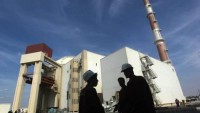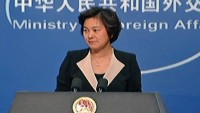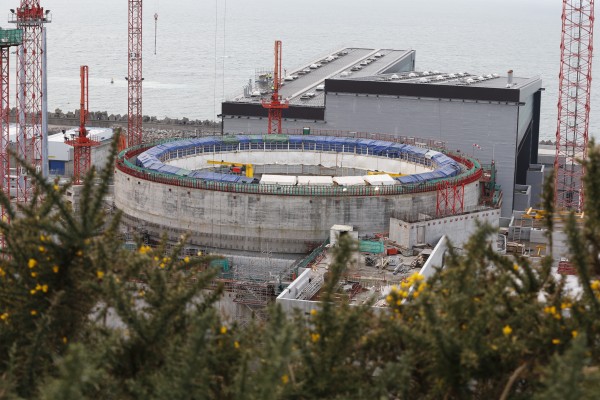China’s Nuclear Reactor Program Could Be The World’s Largest, Expert Says
| Rubi Valdez | | Oct 23, 2014 07:47 AM EDT |
(Photo : Reuters/Charles Platiau)
With deepening concerns in energy sources and biochemical hazards, China is joining the bandwagon of countries that are developing its nuclear reactor programs.
The Institute of Nuclear Energy Safety Technology (INEST), situated in the northwestern part of Anhui Province, is China's hub to what could be the largest nuclear site in the world.
Like Us on Facebook
INEST Director Wu Yican said the Chinese government is prioritizing safe nuclear reactor projects in preparation to the effects of Fukushima nuclear accident. The concept of "sub-critical reactor", Wu added, tackles the processing of nuclear waste to turn into fuel and alternative energy.
According to Wu, the nuclear safety technology is operated using KYIN-II loop, a patented multi-functional bismuth platform that is first built in China. However, he added that the future of nuclear science in the country is a long journey ahead with less than 1,000 researchers working in the field.
The so-called fourth-generation nuclear technology gives emphasis on "inherent safety" standards, which means that all nuclear wastes are either recycled or thrown away with little to no danger to humans or the environment.
The number of INEST scientific researchers has increased to 400 from 30 initially together with 200 published academic papers, 50 invention patents, and 20 scientific recognition.
Wu hopes that more attention and labor will be given in this kind of work to aid people's awareness about the importance of nuclear safety.
To date, China has established 20 nuclear reactors to date and is expected to reach 100 by year 2020. Wu said that although China is quite behind in the schedule of developing its nuclear technology, its facilities and technology is one of the best in the world.
China is now facing energy backlogs, a dilemma similar to other Asian countries. Being the world's largest consumer manufacturer, China needs to cover the energy needed, which windmills and solar panels cannot provide. Coal, when burnt, causes smog that is hazardous as the Air Quality Index dropped to critical levels last October 10.
Currently, more than 30 nations are developing their nuclear program with approximately 400 reactors built in the past 70 years. Historically, only three major accidents were recorded in Three-Mile Island, United States (1979), Chernobyl in the old Russia (1986), and Fukushima, Japan (2011).
TagsInstitute of Nuclear Energy Safety Technology, Nuclear technology, Nuclear energy policy
©2015 Chinatopix All rights reserved. Do not reproduce without permission
 Iran Nuclear Program Talks Make Some Progress, Deal Breakthrough Remains Elusive
Iran Nuclear Program Talks Make Some Progress, Deal Breakthrough Remains Elusive Iran Nuclear Talks Move Forward, Albeit At A Snail’s Pace
Iran Nuclear Talks Move Forward, Albeit At A Snail’s Pace Iranian President ‘Certain’ Nuclear Deal Will Push Through
Iranian President ‘Certain’ Nuclear Deal Will Push Through China Eager For Iran To Reach Nuclear Deal
China Eager For Iran To Reach Nuclear Deal Iran Defends Denial Of Entry To UN Nuclear Expert Amid Probe
Iran Defends Denial Of Entry To UN Nuclear Expert Amid Probe Iran’s Nuclear Program, Civilian Deaths Dominate Netanyahu-Obama Meeting
Iran’s Nuclear Program, Civilian Deaths Dominate Netanyahu-Obama Meeting
EDITOR'S PICKS
-

Did the Trump administration just announce plans for a trade war with ‘hostile’ China and Russia?
-

US Senate passes Taiwan travel bill slammed by China
-

As Yan Sihong’s family grieves, here are other Chinese students who went missing abroad. Some have never been found
-

Beijing blasts Western critics who ‘smear China’ with the term sharp power
-

China Envoy Seeks to Defuse Tensions With U.S. as a Trade War Brews
-

Singapore's Deputy PM Provides Bitcoin Vote of Confidence Amid China's Blanket Bans
-

China warns investors over risks in overseas virtual currency trading
-

Chinese government most trustworthy: survey
-

Kashima Antlers On Course For Back-To-Back Titles
MOST POPULAR
LATEST NEWS
Zhou Yongkang: China's Former Security Chief Sentenced to Life in Prison

China's former Chief of the Ministry of Public Security, Zhou Yongkang, has been given a life sentence after he was found guilty of abusing his office, bribery and deliberately ... Full Article
TRENDING STORY

China Pork Prices Expected to Stabilize As The Supplies Recover

Elephone P9000 Smartphone is now on Sale on Amazon India

There's a Big Chance Cliffhangers Won't Still Be Resolved When Grey's Anatomy Season 13 Returns

Supreme Court Ruled on Samsung vs Apple Dispute for Patent Infringement

Microsoft Surface Pro 5 Rumors and Release Date: What is the Latest?










